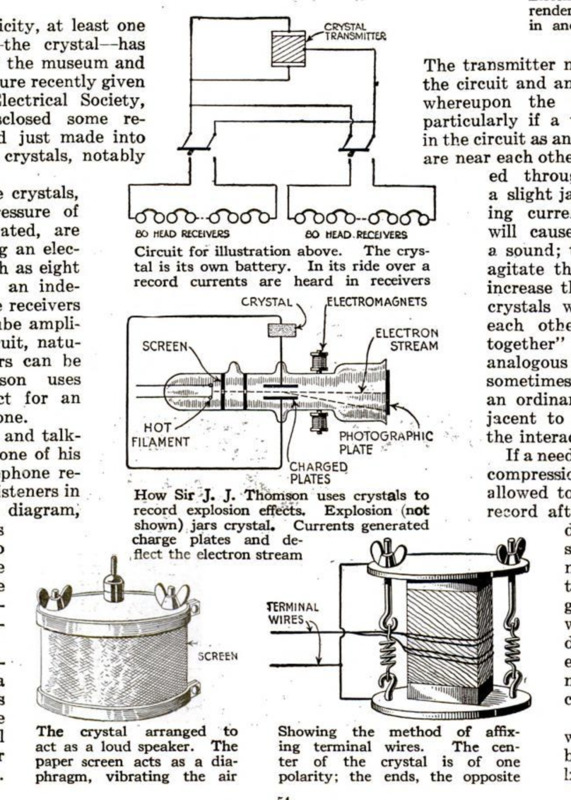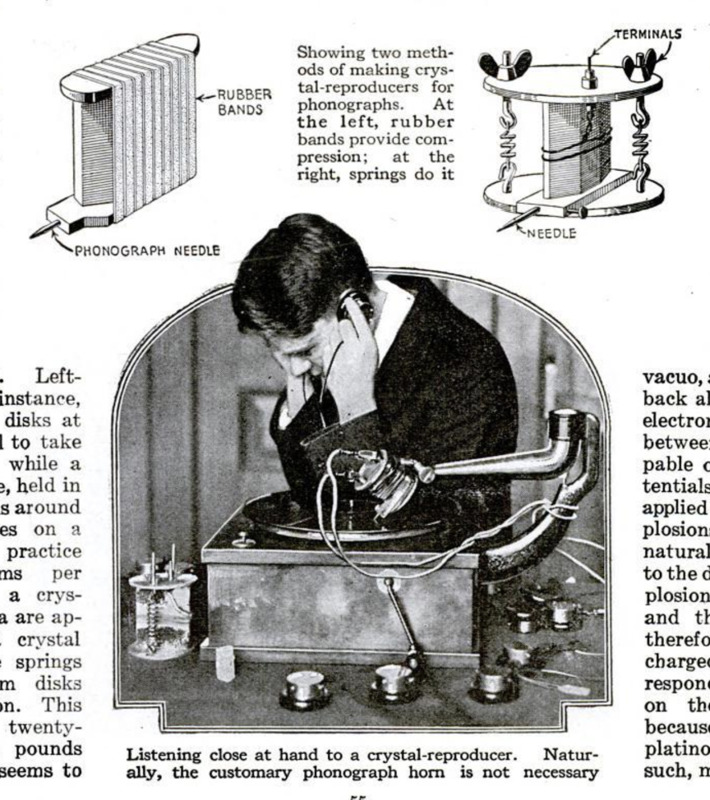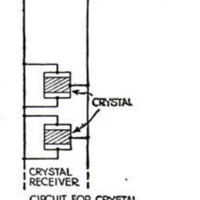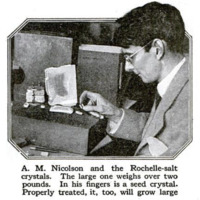-
Title (Dublin Core)
-
How crystals could be used to measure gun explosions
-
Article Title and/or Image Caption (Dublin Core)
-
Making Crystals Speak. Not alone do crystals speak in this new science, but phonographs are operated and gun explosions measured
-
extracted text (Extract Text)
-
AS a producer of electricity, at least one
of the old-timers —the ecrystal-has
been brought out of the museum and
laboratory class. In a lecture recently given
before the New York Electrical Society,
Mr. A. M. Nicolson disclosed some re-
markable studies he had just made into
the properties of certain crystals, notably
Curiously enough, these crystals,
when subjected to a pressure of
several pounds and agitated, are
quite capable of furnishing an elec-
tromotive force of as much as eight
volts, enough to operate an inde-
finite number of telephone receivers
in series. If a vacuum-tube ampli-
fier is inserted in the circuit, natu-
rally many more receivers can be
controlled. ~ Mr. Nicolson uses
this “piezo-electric” effect for an
uncommon kind of telephone.
Going out of the room, and talk-
ing in close proximity to one of his
crystals connected to telephone re-
ceivers at the ears of his listeners in
the manner shown in the diagram,
he is able to make his
speech plainly heard. No
battery is necessary. The
sound waves striking the
crystal agitate it suffi-
cently to produce the nec-
essary currents.
Conversely, if a tele
phone transmitter and a
crystal are connected as
shown at the top of the
opposite page, the crystal
will reproduce whatever
is said in the transmitter.
The transmitter may even be taken out of
the circuit and another crystal substituted,
whereupon the arrangement will work,
particularly if a vacuum tube be inserted
in the circuit as an amplifier. If two crystals
are near each other and electrically connect-
ed through an amplliying ube,
a slight jar will start one to send-
ing currents to the other. This
will cause the other to give off
a sound; the sound will, of course,
agitate the first crystal more, and
increase the effect. Presently both
crystals will be making noises at
each other. A curious “talking
together” effect results. It is
analogous to the whistling sound
sometimes obtainable by holding
an ordinary telephone receiver ad-
jacent to a telephone transmitter,
the interactions being the same.
If a needle be inserted in one of the
compression plates of a crystal and
allowed to ride over a phonograph
record after the manner of an or-
dinary reproducer, the
selection on the record
may be made audible in
telephone receivers with
great fidelity — all this
without all the customary
diaphragms of reproduc-
ers, or the batteries ordi-
narily found in telephone
circuits.
That certain crystals,
when compressed, would
become electrified has been
Lnown for many years.
“ Piezo - electric
effect” is the
term usually ap-
plied to this
phenomenon.
“Piezo
comes from
the Greek
piczein,
meaning “to
press.” The
“pyro-elec-
tricity” of the
ancients,
though de-
rived primar-
ily from heat-
ing, was of
this general
nature. Mr.
Nicolson’s
work consists
in getting
something
somewhere
near practical out of this old phe-
nomenon. And surely he has suc-
ceeded.
The investigator clamps his crystals
between aluminum disks in the man-
ner made clear in the illustrations.
Pressure is applied by means of the
thumbscrews. During this process
electricity is given off, the voltage
rising as the pressure increases. There-
after, if the crystal and its framework
be agitated in any manner, as by the
tick of a watch, or by a voice, or by
anything whatever, a potential will
appear between the
electrical poles of the
crystal, the potential
being dependent upon
the pressure under
which the crystal is
operating, the ticks of
the watch or a similar
sound producing the
potential at every tick.
Eight volts is a com-
mon potential so ob-
tained.
Torsional or twist-
ing forces, applied to
the crystal while un-
der compression, also
produce the potential. Left-
hand torsion, for instance,
causes the aluminum disks at
the ends of the crystal to take
on a negative charge, while a
strip of tinfoil, or girdle, held in
place with rubber bands around
the middle part, takes on a
positive charge. In practice
about two kilograms per
square centimeter of a crys-
tal's cross-sectional area are ap-
plied lengthwise of a erystal
by tightening up the springs
holding the aluminum disks
shown in the illustration. This
pressure is, roughly, twenty-
eight or twenty-nine pounds
per square inch, and seems to
give maximum variation of the piezo
potential. Ten kilograms per square
centimeter (about one hundred and
forty pounds per square inch) causes
the saturation point to be reached.
Mr. Nicolson grows these erys-
tals out of jars full of saturated
solution of the salts, starting with a
small crystal as a “seed.” That
is, if one takes a small erystal of
Rochelle salts, or almost any other
salt for that matter, and places it in
a saturated solution of the same.sub-
stance, leaving it undisturbed for
hours or days, the small crystal will
grow into one infinitely larger. One of
the illustrations herewith shows the
investigator with one of the hugest
crystals he has grown in this manner.
This one weighs over two pounds.
Mr. Nicolson's work has been pro-
ductive of much that is interesting.
Sir J. J. Thomson recently an-
nounced before the Royal Institu-
tion in England investigations of
somewhat similar character. But,
instead of having experimented so
much with telephonic applications,
he suggests that a ‘good method to
get practical service from piezo-clec-
tries would be to use the crystals to
‘measure instantaneous pressures in
the explosion-chambers of guns, gas
engines, and similar appliances.
Knowing exactly what goes on with-
in a gun or a gas engine makes
possible designing them for maxi-
mur efficiency, a highly desirable
end and not always obtainable at
present because of the limitations
of existing measuring appliances.
According to Thomson's plans, a
tourmaline crystal, properly en-
cased, would be exposed to the ex-
plosive pressures to be measured. A
suitable small pocket at one side of the
explosion chamber might make this
possible, or in the case of guns the
barrel might be prolonged, and the
extension utilized for the mounting
of the apparatus in an effective way.
Owing to the fact that the voltage *
given off by tourmaline is directly pro-
portional to the pressure to which it is
subjected, and that the voltage al-
most instantaneously responds to this
pressure, in the opinion
of Sir Joseph, a crys-
tal would be an excel-
lent medium for meas-
uring explosions of
1/30,000 to 1/50,000 of
a second in duration,
such as frequently
occur in guns and gas
engines.
Under this plan, the
apparatus would be
connected as shown in
the figure near the
bottom of page 54. A
hot filament gives off
an electron stream in
vacuo, asuitablescreen holding
back all buta narrow beam of
electrons. This beam passes
between two metal plates ca-
pable of being charged by po-
tentials resulting from pressures
applied to the crystal during ex-
plosions. These potentials are
naturally directly proportional
to the degree of pressure the ex-
plosion inflicts on the crystal,
and the electron stream will
therefore be deflected by the
charged platesin an exactly cor-
responding amount, registering
on the photographic plate
because an intervening barium
platino - cyanide coating or
such, makes its path luminous.
-
Contributor (Dublin Core)
-
Lloyd E. Darling (writer)
-
Language (Dublin Core)
-
eng
-
Date Issued (Dublin Core)
-
1919-09
-
pages (Bibliographic Ontology)
-
54-55
-
Rights (Dublin Core)
-
Public domain (Google digitized)
-
Archived by (Dublin Core)
-
Davide Donà
-
Alberto Bordignon (Supervisor)
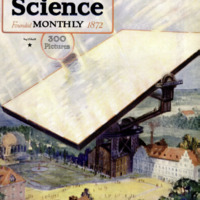 Popular Science Monthly, v. 95, n. 3, 1919
Popular Science Monthly, v. 95, n. 3, 1919


